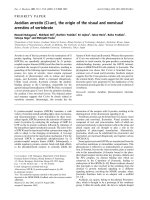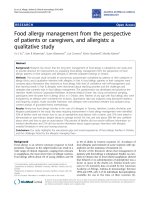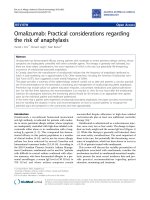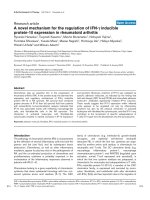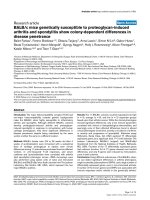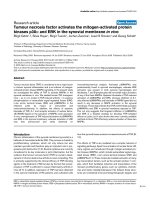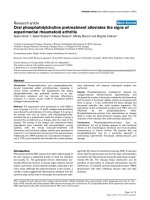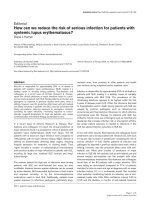Báo cáo y học: "Low-intensity pulsed ultrasound activates the phosphatidylinositol 3 kinase/Akt pathway and stimulates the growth of chondrocytes in three-dimensional cultures: a basic science study" pot
Bạn đang xem bản rút gọn của tài liệu. Xem và tải ngay bản đầy đủ của tài liệu tại đây (1.9 MB, 11 trang )
Open Access
Available online />Page 1 of 11
(page number not for citation purposes)
Vol 10 No 4
Research article
Low-intensity pulsed ultrasound activates the
phosphatidylinositol 3 kinase/Akt pathway and stimulates the
growth of chondrocytes in three-dimensional cultures: a basic
science study
Ryohei Takeuchi
1
, Akihide Ryo
2,3
, Noriko Komitsu
1
, Yuko Mikuni-Takagaki
4
, Atsuko Fukui
1
,
Yuta Takagi
5
, Toshihiko Shiraishi
5
, Shin Morishita
5
, Yoshiyuki Yamazaki
1
, Ken Kumagai
1
,
Ichiro Aoki
3
and Tomoyuki Saito
1
1
Department of Orthopaedic Surgery, Yokohama City University School of Medicine, 3-9 Fukuura, Kanazawa-ku, Yokohama City, Kanagawa 236-
0004, Japan
2
First Research Group, AIDS Research Center, National Institute of Infectious Diseases, 4-7-1 Gagkuen, Musashimurayama, Tokyo 208-0011, Japan
3
Department of Pathology, Yokohama City University School of Medicine, 3-9 Fukuura, Kanazawa-ku, Yokohama City, Kanagawa 236-0004, Japan
4
Department of Functional Biology, Kanagawa Dental College, 82 Inaokachyo, Yokosuka City, Kanagawa 238-8580, Japan
5
Department of Environment and Information Sciences, Yokohama National University Graduate School, 79-5 Tokiwadai, Hodogaya-ku, Yokohama
City, Kanagawa 240-851, Japan
Corresponding author: Ryohei Takeuchi,
Received: 22 Nov 2007 Revisions requested: 21 Dec 2007 Revisions received: 6 Jun 2008 Accepted: 11 Jul 2008 Published: 11 Jul 2008
Arthritis Research & Therapy 2008, 10:R77 (doi:10.1186/ar2451)
This article is online at: />© 2008 Takeuchi et al.; licensee BioMed Central Ltd.
This is an open access article distributed under the terms of the Creative Commons Attribution License ( />),
which permits unrestricted use, distribution, and reproduction in any medium, provided the original work is properly cited.
Abstract
Introduction The effect of low-intensity pulsed ultrasound
(LIPUS) on cell growth was examined in three-dimensional-
cultured chondrocytes with a collagen sponge. To elucidate the
mechanisms underlying the mechanical activation of
chondrocytes, intracellular signaling pathways through the Ras/
mitogen-activated protein kinase (MAPK) and the integrin/
phosphatidylinositol 3 kinase (PI3K)/Akt pathways as well as
proteins involved in proliferation of chondrocytes were examined
in LIPUS-treated chondrocytes.
Methods Articular cartilage tissue was obtained from the
metatarso-phalangeal joints of freshly sacrificed pigs. Isolated
chondrocytes mixed with collagen gel and culture medium
composites were added to type-I collagen honeycomb sponges.
Experimental cells were cultured with daily 20-minute exposures
to LIPUS. The chondrocytes proliferated and a collagenous
matrix was formed on the surface of the sponge. Cell counting,
histological examinations, immunohistochemical analyses and
western blotting analysis were performed.
Results The rate of chondrocyte proliferation was slightly but
significantly higher in the LIPUS group in comparison with the
control group during the 2-week culture period. Western blot
analysis showed intense staining of type-IX collagen, cyclin B
1
and cyclin D
1
, phosphorylated focal adhesion kinase, and
phosphorylated Akt in the LIPUS group in comparison with the
control group. No differences were detected, however, in the
MAPK, phosphorylated MAPK and type-II collagen levels.
Conclusion LIPUS promoted the proliferation of cultured
chondrocytes and the production of type-IX collagen in a three-
dimensional culture using a collagen sponge. In addition, the
anabolic LIPUS signal transduction to the nucleus via the
integrin/phosphatidylinositol 3-OH kinase/Akt pathway rather
than the integrin/MAPK pathway was generally associated with
cell proliferation.
Introduction
The degenerative abrasion of cartilage tissue due to aging and
a malalignment of the lower extremities causes osteoarthritis.
Moreover, articular cartilage is a tissue that is difficult to
3D = three-dimensional; DMEM = Dulbecco's modified Eagle's medium; FAK = focal adhesion kinase; FBS = fetal bovine serum; LIPUS = low-inten-
sity pulsed ultrasound; MAPK= mitogen-activated protein kinase; PBS = phosphate-buffered saline; PCNA = proliferating cell nuclear antigen; PI3K=
phosphatidylinositol 3-OH kinase.
Arthritis Research & Therapy Vol 10 No 4 Takeuchi et al.
Page 2 of 11
(page number not for citation purposes)
regenerate once damaged. Many attempts have therefore
been made to achieve regeneration of damaged cartilage tis-
sue. Conservative treatments include physiotherapy, such as
quadriceps muscle training, or the intra-articular injection of
hyaluronic acid. The regeneration of normal cartilage tissue,
however, has not yet been achieved [1]. The elements that
promote the regeneration of cartilage include growth factors
[2], soluble mediators [3], corrections of any malalignment and
mechanical stimulation [4-6].
Surgical treatments include a high tibial osteotomy, the micro-
fracture method, transplantation of osteocartilaginous plugs
[7], and transplantation of cultured cartilage [8]. During the
transplantation of cultured cartilage, a key part of the proce-
dure is the in vitro preparation of high-quality cartilage tissue
prior to transplantation [9]. Mechanical stimulation is one of
the essential factors that promotes the differentiation and pro-
liferation of intact chondrocytes as well as in vitro cultures for
transplantation. Various methods of mechanical stimulation of
chondrocytes have been reported, such as loading with hydro-
static pressure [10], the application of tensile stress against
the culture scaffold [11], oscillation using a vibrator [12] and
low-intensity pulsed ultrasound (LIPUS) [13-15].
The matrix surrounding the chondrocytes also plays an impor-
tant role in the proliferation and survival of chondrocytes.
Through this extracellular matrix, chondrocytes receive various
kinds of extracellular information such as mechanical signals
and hormonal mediators. Mechanical stimulation has been
reported to activate chondrocytes and to promote their syn-
thesis of the extracellular matrix. Few reports have focused on
the signal transmission, however, which results in chondrocyte
activation. To characterize these mechano-transduction path-
ways in chondrocytes, we have previously established a new
three-dimensional (3D) culture system, which forms a tissue
architecture similar to the structure of articular cartilage tissue
in vivo [12]. The effects of vibration on chondrocytes were
previously examined in this system, and the involvement of a
mechano-transduction pathway via the integrin/mitogen-acti-
vated protein kinase (MAPK) pathway and of another signaling
pathway via β-catenin was evaluated. Although many previous
studies reported that osteoblasts are activated by LIPUS,
which has been widely used in clinical settings to accelerate
the process of fracture healing, its practical use for cartilage
repair in a clinical setting is so far limited [16-18].
The present study demonstrates that the combination of the
3D chondrocyte culturing technique with LIPUS not only pro-
motes the production of type-IX collagen, but also significantly
increases the number of chondrocytes. In addition, the results
indicate the potential involvement of the integrin/phosphati-
dylinositol 3-OH kinase (PI3K)/Akt pathway downstream of
LIPUS exposure, rather than the integrin/MAPK/MAPK kinase
pathway, which is generally involved in the induction of cellular
proliferation.
Materials and methods
Cell cultures
Articular cartilage tissue was obtained from the metatarso-
phalangeal joints of freshly slaughtered 6-month-old pigs in a
slaughterhouse. Articular cartilage slices were cut into smaller
pieces, and the cartilage specimens were washed well in PBS
(pH 7.4) and digested with 0.25% trypsin–ethylenediamine
tetraacetic acid (Gibco, Grand Island, NY, USA) for 20 min-
utes. The resultant chondrocyte preparations were washed
again with PBS to remove the trypsin, and were then incu-
bated for about 8 hours in Dulbecco's modified Eagle's
medium (DMEM; Gibco) supplemented with 0.1% type-II col-
lagenase (Worthington Biochemical Co., Lakewood, OH,
USA), 10% heat-inactivated FBS (Equitech-Bio, Inc., Kerrville,
TX, USA) and antibiotics. The chondrocytes were subse-
quently isolated and washed with culture medium, collected
by centrifugation (2,000 rpm, 37°C, 5 min), and then mixed
with 0.2% atelocollagen gel (type-I collagen derived from
bovine tendons; Koken Co., Tokyo, Japan) containing culture
medium (DMEM; Gibco).
Twenty-four-well plates containing type-I honeycomb collagen
sponges (discs with a diameter of 15 mm and thickness of 2
mm; Koken Co.) at the bottom of each well were used as 3D
carriers of the chondrocyte culture [19]. Chondrocytes in the
atelocollagen gel and also chondrocytes in the culture medium
composites were added to each sponge and were incubated
at 37°C for 1 hour. The final cell density was adjusted to 2 ×
10
6
cells/well/ml [12]. After the collagen sponge and cell–col-
lagen gel composites became stiff, they were then incubated
with 2 ml complete DMEM in 5% CO
2
/95% air at 37°C, and
the cultured medium was replaced with fresh DMEM contain-
ing
L-ascorbic acid (50 μg/ml) twice weekly.
Low-intensity pulsed ultrasound stimulation
The sonic accelerated fracture healing system (Exogen Inc.,
Piscataway, NJ, USA), a LIPUS apparatus, was used to deliver
an ultrasound signal. The sonic accelerated fracture healing
system is one of the instruments in current clinical use in cases
of delayed repair of a fracture. The temporal average intensity
was 30 mW/cm
2
and the frequency was 1.5 MHz with a 200-
μs tone burst repeated at 1.0 KHz. LIPUS was applied to the
chondrocytes after 24 hours in culture through the bottom of
the culture dish (24-well plate) via a coupling gel and silicon
rubber that had been placed between the LIPUS transducer
and the dish. LIPUS was administered for 20 minutes every
day in a span of this experiment. Control samples were pre-
pared in the same manner without LIPUS. Thereafter, the cul-
tured tissues and their supernatant medium were harvested at
days 3, 7, 10 and 14.
Cell counting
The cartilage tissues were harvested 1, 3, 7, 10 and 14 days
after culture (2 hours after the last LIPUS) and were cut into
smaller pieces. Each sample was then incubated for about 8
Available online />Page 3 of 11
(page number not for citation purposes)
hours in DMEM (Gibco) supplemented with 0.1% type-II col-
lagenase (Worthington Biochemical Co.), 10%-heat-inacti-
vated FBS (Equitech-Bio, Inc.) and antibiotics. The
chondrocytes were then isolated, washed with culture
medium, and collected by centrifugation (2,000 rpm, 37°C, 5
min). After the supernatant medium was removed, a solution
containing 0.1 M. citric acid and 0.1% crystal violet was added
to the cells and then the cells were counted using a hemocy-
tometer (Burker-Turk, Tokyo, Japan).
Histological examinations
Histological evaluations of the specimens were conducted at
weeks 1 and 2 post culture. The specimens were fixed over-
night in 4% paraformaldehyde in PBS, paraffin-embedded,
sectioned to a 5 μm thickness, and were stained with Alcian
blue and Safranin O. For each sample, at least two different
section levels and two histological sections for each level were
analyzed. The sections were analyzed and photographed
using an Olympus photomicroscope BX-50 (Olympus Co.,
Tokyo, Japan).
Immunohistochemistry
Immunohistochemical analyses were conducted with antibod-
ies raised against anti-type-II collagen antibody (1:100; Fuji
Pharm. Lab., Toyama, Japan) and against anti-type-IX collagen
(1:100; Chemicon International, Billerica, MA, USA) using
week 1 and week 2 postcultures to evaluate the expression of
the chondrocyte phenotype and also to assess the type-II and
type-IX collagen production levels. The specimens from the 1-
week and 2-week postcultures that were harvested 2 hours
after the last LIPUS were fixed in 4% paraformaldehyde in 0.1
M PBS (pH 7.4), and 16-μm cryostat sections were made.
For further confirmation of chondrocyte growth, Ki67 staining
was performed because this factor has been shown to be a
very reliable proliferation marker [20]. The monoclonal mouse
anti-human antibody Ki67 (MIB1; DAKO, Glostrup, Denmark),
which also shows cross-reactivity with porcine tissues, was
used to determine the extent of proliferation. The sections cul-
tured at day 7 were incubated with this Ki67 primary antibody,
followed by a secondary biotinylated anti-rabbit antibody and
horseradish peroxidase–avidin complex (DAKO). The color
reaction was developed by 3,3'-diaminobenzidine substrate,
followed by counterstaining with hemalaun (Merck, Frankfult,
Germany). Chondrocytes showing a definite nuclear staining
pattern were scored as positive. All slides were reviewed by
two investigators without any prior knowledge of the experi-
ment. Five different randomly chosen areas were reviewed in
five different specimens, and the number of Ki67-positive cells
per 100 chondrocytes was counted in each slice. The per-
centages of positive cells (MIB1 index) were then calculated.
Quantitative evaluations were conducted using specimens
stained with an anti-β-catenin antibody (Acris, Herford, Ger-
many). The nuclear translocation of β-catenin was visible by
brown staining. After counting 100 cells, the ratio of the cells
whose nuclei were stained brown was compared between the
ultrasound group and the control group. All slides were
reviewed by two investigators without any prior knowledge of
the experiment. In five different randomly chosen areas in five
different specimens, the number of β-catenin antibody-positive
stained cells per 100 chondrocytes was counted in each slice.
The percentages of positive cells were then calculated.
Western blotting analysis
For the western blotting analysis of the specimens cultured for
1 week, cartilage tissues specimens were harvested 2 hours
after the last LIPUS and were cut into smaller pieces. Each
sample was then incubated for about 8 hours in DMEM
(Gibco) supplemented with 0.1% type-II collagenase (Wor-
thington Biochemical Co.), 10%-heat-inactivated FBS
(Equitech-Bio, Inc.) and antibiotics. The chondrocytes were
then isolated, washed with culture medium, and collected by
centrifugation (2,000 rpm, 37°C, 5 min). After the supernatant
medium was removed, the cells were rinsed with 200 μl PBS,
filtered by centrifugation, and added to a 200 μl aliquot of 2×
sample buffer (62.5 mmol/l Tris–HCl (pH 6.8), 2% SDS, 10%
glycerol, 50 mmol/l dithiothreitol, 0.01% bromophenol blue).
The cell lysates were then boiled for 10 minutes at 75°C.
Equal amount of the proteins were separated on a 10% SDS–
polyacrylamide gel at 200 V, 25 mA for 80 minutes and were
transblotted to nitrocellulose membranes (Millipore, Billerica,
MA, USA) using a wet transfer system (BIO-RAD, Hercules,
CA, USA) at 200 V, 150 mA for 60 minutes. The membranes
were blocked with blocking buffer (5% skimmed milk in TBS
and 0.05% Tween 20 and Blocking One–P; Nacalai Tesque
Inc., Kyoto, Japan) and were incubated with the following anti-
bodies: anti-Akt (Rockland, Gilbertsville, PA, USA), anti-phos-
pho-Akt (Cell Signaling Technology, Beverly, MA, USA), anti-
MAPK and anti-phospho-MAPK (Cell Signaling Technology),
anti-cyclin D
1
(Biosource, Camarillo, CA, USA), anti-cyclin B
1
and anti-focal adhesion kinase (anti-FAK; Upstate Cell Signal-
ing Solutions, NY, USA), anti-phospho-FAK (Rockland), anti-
collagen-II (Chemicon International), and anti-collagen-IX (Cell
Signaling Technology).
After incubation with the corresponding horseradish peroxi-
dase-conjugated secondary antibodies (dilution: 1/5,000),
membranes were finally incubated with a chemiluminescent
reagent (NEL103; Perkin Elmer Life Science, Fremont, CA,
USA) and the signals produced were recorded on X-ray film
(BIOMAX XAR Film, Rochester, Minesota, USA) for a densito-
metric analysis. The effects of PI3K inhibitor (LY294002; Cell
Signaling Technology) and MEK1 inhibitor (PD98059; Cell
Signaling Technology) for cell growth were studied. Chondro-
cytes were pretreated with MEK1 inhibitor (250 μM/ml) and
PI3K inhibitor (250 μM/ml) for 12 hours and 24 hours, fol-
lowed by stimulation with LIPUS for 20 minutes. Each sample
was harvested 2 hours after LIPUS stimulation and the
Arthritis Research & Therapy Vol 10 No 4 Takeuchi et al.
Page 4 of 11
(page number not for citation purposes)
influence of these inhibitors was judged by western blotting
analysis of proliferating cell nuclear antigen (PCNA; DAKO).
Statistical analysis
Data are expressed as the mean ± standard deviation. Quan-
titative evaluations of Ki67-positive cells and β-catenin-posi-
tive cells were assessed by Mann–Whitney's U test. The
change in the number of chondrocytes was assessed using
repeated-measures analysis of variance. P < 0.05 was consid-
ered significant.
Results
Histological specimens
After 1 week of culture, cartilaginous tissue consisting of at
least five cell layers was formed on the collagen sponges in
both the control group and the LIPUS group (Figure 1a to 1d).
Simultaneously, both the penetration of chondrocytes and the
formation of an extracellular cartilage matrix were observed
inside the collagen sponge. In addition, an extracellular matrix
rich in proteoglycans and intensively stained with Alcian blue
and Safranin O was observed surrounding the chondrocytes.
During week 2 of culture in the 3D system, the cartilaginous
tissue in each specimen appeared thicker in comparison with
week 1, and the volume of the extracellular matrix had also
increased and formed a stable cartilaginous tissue. The thick-
ness of the tissue in week 2 was found to be greater in the
LIPUS group than in the control group, and the staining of the
matrix, especially near the surface, was also more intense in
the LIPUS group (Figure 1e to 1h). The ratio between the
number of cells in the cartilage layer that had formed on the
collagen sponge and in the sponge was approximately 2:1.
Growth curves of the chondrocytes
The initial results demonstrated that LIPUS facilitates the for-
mation of a 3D structure of cartilage tissue, suggesting that
increased cell proliferation had occurred. The effect of LIPUS
on cell proliferation was therefore examined in the culture sys-
tem. The number of live chondrocytes on day 0 was (13.6 ±
0.8) × 10
5
and (12.9 ± 0.6) × 10
5
cells in the control and
LIPUS groups, respectively. A time-dependent increase in the
total number of chondrocytes was noted, and on day 14 the
cell counts were (30.4 ± 0.8) × 10
5
and (33.0 ± 1.7) × 10
5
in
the control group and the LIPUS group, respectively. There
was therefore a small but significantly greater increase in the
cell number observed in the LIPUS group in comparison with
the control group (P < 0.01; Figure 2).
Type-II collagen and type-IX collagen
Collagen is essential for the formation of cartilage tissue and
also for the proliferation of chondrocytes. Furthermore, the
current results demonstrated the formation of a thicker carti-
laginous structure following LIPUS – suggesting that the
increased secretion of extracellular matrix components such
as the collagens had occurred.
Following type-II collagen antibody staining, both the chondro-
cyte layers, which formed cartilaginous tissue on the collagen
sponge, and the matrix formed inside the sponge were
strongly positive in both the LIPUS group and the control
group. There were also no apparent differences in the
Figure 1
High-magnification sections of chondrocyte–collagen sponges 1 week after cultureHigh-magnification sections of chondrocyte–collagen sponges 1
week after culture. Cartilage layers with a laminar structure on the col-
lagen sponges (green arrows) and a grey structure, which represents
the walls of collagen sponges (black arrows), are visible at high magni-
fication (100×). (a) to (d) Specimens at week 1 of culture. (a) and (b)
Alcian blue staining, and (c) and (d) Safranin O staining: many chondro-
cytes with blue-stained and red-stained peripheral matrices could be
observed, respectively. The chondrocytes exhibited a layer structure,
and their infiltration into the sponge can also be observed. (e) to (h)
Specimens at week 2 of culture. (e) and (f) Alcian blue staining, and (g)
and (h) Safranin O staining: many chondrocytes with blue-stained and
red-stained peripheral matrices can be observed, respectively. The
layer of chondrocytes that formed on the surface of the sponge was
found to be thicker in comparison with the week 1 cultures, and the vol-
ume of the extracellular matrix had also increased. The cartilage tissue
that formed on the surface of the sponge consisted of more than 10
layers of chondrocytes. The staining of the extracellular matrix in the
LIPUS group was also found to be stronger than in the control group.
Available online />Page 5 of 11
(page number not for citation purposes)
intensities of this staining between these two groups (Figure
3a to 3d).
Type-IX collagen antibody staining of the culture specimens
showed the intensity of this staining in the chondrocyte layers
on the sponge to be far stronger in the LIPUS group than in
the control group after 2 weeks of culture, thus indicating an
accumulation of type-IX collagen (Figure 3e to 3h).
Ki67 and β-catenin
Immunohistochemical staining with Ki67 revealed distinctive
labeling in the chondrocyte nuclei (Figure 4a,b). The cells with
brown-stained nuclei were considered Ki67-positive. The
large number of Ki67-positive cells indicated that LIPUS stim-
ulated cell proliferation. In the cells in which β-catenin had
translocated to the nucleus, brown nuclear staining with an
anti-β-catenin antibody was evident (Figure 4c,d).
Quantitative evaluation of both Ki67-positive cells and β-
catenin-positive cells
The Ki67 index of the chondrocytes exposed to LIPUS was
found to be 48 ± 3.7%, in comparison with 41 ± 3.0% in the
control group (Figure 5a), which was significantly different.
The average percentage of β-catenin-positive cells with
brown-stained nuclei (that is, positive cells) was determined to
be 42 ± 4.9% in the LIPUS group and 32 ± 2.7% in the con-
trol group. This indicated a significant difference between the
two groups (Figure 5b).
Figure 2
Growth curves of the cells in the chondrocyte–collagen sponges (n = 7)Growth curves of the cells in the chondrocyte–collagen sponges (n
= 7). A time-dependent increase in the number of chondrocytes can be
seen in both the low-intensity pulsed ultrasound (LIPUS) group (US+)
and in the control group (US-). The rate of increase in the chondrocytes
number was significantly greater, however, in the LIPUS group in com-
parison with the control group (P < 0.01). The change in the number of
chondrocytes was assessed using repeated-measures analysis of
variance.
Figure 3
High-magnification sections of chondrocyte–collagen sponges 1 and 2 weeks post cultureHigh-magnification sections of chondrocyte–collagen sponges 1
and 2 weeks post culture. Sections of chondrocyte–collagen
sponges 1 and 2 weeks post culture at high magnification (anti-colla-
gen antibody type-II and type-IX stain, 100×). (a), (b) Anti-type-II colla-
gen antibody staining of specimens after week 1 of culture. Brown
staining of the matrix with anti-collagen type-II antibodies can be
observed around the chondrocytes, indicating production of this colla-
gen. (c), (d) Anti-type-II collagen antibody-stained specimens after
week 2 of culture. Strong brown staining of the matrix can be observed
around the cells at a similar level in both groups. (e), (f) Anti-type-IX
collagen antibody-stained specimens after week 1 of culture. Positive
brown staining of the matrix with anti-type-IX collagen antibodies can
be observed around the cells, thus indicating the production of this col-
lagen around the chondrocytes. (g), (h) Anti-type-IX collagen antibody
stained specimens after week 2 of culture. Positive brown staining of
the matrix with anti-type-IX collagen antibodies can be observed around
the cells, thus indicating production of this collagen around the
chondrocytes.
Arthritis Research & Therapy Vol 10 No 4 Takeuchi et al.
Page 6 of 11
(page number not for citation purposes)
Western blotting analysis
Collagen type-II
A western blot analysis showed immunoreactive bands for col-
lagen type-II were observed at about 200 kDa, and were found
to be present at a similar intensity in the LIPUS group and the
control group (Figure 6a).
Collagen type-IX
An immunoreactive western band for collagen type-IX of about
110 kDa was detected at a higher level in the LIPUS group in
comparison with the control group (Figure 6b).
FAK, phosphorylated FAK, Paxillin and phosphorylated
Paxillin
Immunoreactive bands corresponding to FAK and phosphor-
Figure 4
Ki67 and β-catenin antibody stainingKi67 and β-catenin antibody staining. (a), (b) Anti-Ki67 antibody staining of week 2 cultures (200× magnification). The nuclei are positively
stained with an anti-Ki67 antibody in both the control group (US-) and the low-intensity pulsed ultrasound (LIPUS) group (US+) (black arrows). (c),
(d) Anti-β-catenin antibody staining of week 2 cultures (200× magnification). The nuclei are positively stained with an anti-β-catenin antibody in both
the control group (US-) and the LIPUS group (US+) (black arrows).
Figure 5
Quantitative evaluation of Ki67-positive cells and β-catenin-positive cellsQuantitative evaluation of Ki67-positive cells and β-catenin-positive cells. After counting 100 cells in each specimen in the low-intensity pulsed
ultrasound (LIPUS) group (US+) and the control group (US-), the numbers of cells with positively stained nuclei were compared for both (a) Ki67
and (b) β-catenin. There were significantly more brown stained cells in the LIPUS group in both cases (P < 0.01).
Available online />Page 7 of 11
(page number not for citation purposes)
ylated FAK were detected by western blotting at about 125
kDa (Figure 6c). Positive bands for Paxillin and its phosphor-
ylated form were observed at about 68 kDa (Figure 6d).
Although the levels of total FAK and Paxillin were similar with
and without LIPUS exposure, the staining of their phosphor-
ylated counterparts was stronger in the LIPUS group than in
the control group (Figure 6c,d). These data thus indicate that
LIPUS exposure results in the activation of both FAK and
Paxillin.
MAPK and phosphorylated MAPK
Whereas MAPK and phosphorylated MAPK (p-42, p-44) were
both detected in both the LIPUS group and the control group,
there were no evident differences in the intensity (Figure 6e).
Akt and phosphorylated Akt
Akt, a cell survival signal, was found to be similarly expressed
in both the LIPUS group and the control group but was
observed to be phosphorylated to a greater extent in the
LIPUS group (Figure 6f). These results indicate that LIPUS
increased cell proliferation in this culture system by preferen-
tially activating the PI3K/Akt pathway rather than the MEK/
MAPK pathway.
Cyclin B
1
and cyclin D
1
Consistent with the increased chondrocyte growth, the
expression of the cell proliferation markers cyclin D
1
and cyclin
B
1
was enhanced in both cases by LIPUS. The expression of
both of these cyclins was also detected at higher levels in the
LIPUS group in comparison with the control group (Figure 6g).
These results confirm that the increase in cell numbers in
response to LIPUS coincide with the enhanced expression of
these two cyclins.
Changes of proliferating cell nuclear antigen using MEK1
inhibitor and PI3K inhibitor
The influence of the MEK1 inhibitor (PD98059) and of the
PI3K inhibitor (LY294002) was judged in western blotting
analysis of PCNA. The expression of PCNA at 12 hours was
decreased by PD98059 in the LIPUS-negative group and was
detected at higher level in the LIPUS-positive group in com-
parison with the LIPUS-negative group, but the expression of
PCNA at 24 hour was completely decreased by this inhibitor
in both the LIPUS-negative and LIPUS-positive groups. Cell
growth according to LIPUS is hypothesized to depend not
only on a MAPK cascade but also on the effect of other signal
transductions. The expression of PCNA at 12 and 24 hours,
however, was completely decreased by PI3K inhibitor
(LY294002).
Discussion
LIPUS promotes proliferation of chondrocytes
Previous studies indicated that LIPUS increases the produc-
tion of the extracellular matrix around chondrocytes, but not
the actual proliferation of the chondrocytes themselves. Zhang
and colleagues have reported that although pulsed low-inten-
sity ultrasound increases the number of hypertrophic chondro-
cytes around the callus of healing fractures, it does not alter
the hyaline cartilage [15]. Nishikori and coworkers have also
reported that chondrocytes can be grown in a 3D collagen gel
without loss of their chondrogenic phenotype but that LIPUS
did not enhance cell proliferation in either a monolayer culture
or a 3D culture [13]. In this same study, ultrasound exposure
was found to be advantageous in inducing chondrocyte pro-
duction of collagen gel composites with mature aggrecan.
Parvizi and colleagues irradiated the rat monolayer culture
cells at 1 MHz to investigate the [
3
H]thymidine incorporation
levels, the DNA contents, the mRNA levels of α(I) and α(II) pro-
collagens and the mRNA contents of proteoglycans inducing
aggrecan. The group reported that the irradiation increased
the aggrecan mRNA and proteoglycan levels without any sig-
nificant effects upon the proliferation of chondrocytes [14].
A number of studies have reported a slight increase in the
number of chondrocytes following the use of the same thera-
peutic low-intensity pulsed ultrasound, which may be called
PLIUS. Zhang and colleagues previously irradiated cultured
chondrocytes at 2 mW/cm
2
and 30 mW/cm
2
, and measured
the cell count and volume of the extracellular matrix over time.
At 2 mW/cm
2
, they reported that the extracellular matrix as
well as the cell number increases significantly but only tran-
siently on day 3 of culture, in comparison with the control
group [15]. In the current study with a 3D culture system, the
number of chondrocytes doubled by the end of the 2-week
incubation in both groups. This rate of increase was slightly
but significantly higher in the LIPUS group.
To further confirm these findings, Ki67 staining of sections
from these cultures was performed because it has been
shown to be a very reliable proliferation marker. The Ki67 index
in the LIPUS group, also significantly higher in comparison
with the control group, again indicated that LIPUS promotes
the proliferation of chondrocytes slightly but significantly. In
terms of cartilage regeneration, even a slight increase in the
number of chondrocytes is very important. In a previous study
performed in vivo by Cook and colleagues, cartilage defects
in New Zealand rabbits were artificially induced by drilling
holes. These defects treated by LIPUS regenerated articular
cartilage earlier than the control group, with a hint of increased
numbers of chondrocytes [21]. In many previous in vitro stud-
ies, the cartilage of small animals such as mice and rats has
been used. Chondrocytes in cartilage of these animals have a
tendency to proliferate more easily, and therefore the regener-
ation of cartilage is easier than in higher animals. The current
study utilized porcine cartilage on the assumption that this is a
more appropriate animal model system for the development of
future treatments in human cartilage.
Arthritis Research & Therapy Vol 10 No 4 Takeuchi et al.
Page 8 of 11
(page number not for citation purposes)
LIPUS promotes production of collagen type-IX
The immunoblotting analysis in the present study indicated
that LIPUS increases the production of collagen type-IX, but
not collagen type-II. These results suggest that LIPUS
transduces the signals through the intracellular signaling path-
way that transactivates the collagen type-IX gene. Although
the major constituent of the cartilage matrix is type-II collagen,
this matrix also contains collagen types of smaller molecular
weights, including type VI, type-IX, type X, type XI, and type XII.
These collagens all play regulatory roles in maintaining carti-
lage. Type-IX collagen is present in zones 1 and 2, and it is
said to be involved in promoting chondrocyte proliferation and
in the expansion of the cartilage layer [22].
In addition, Eyre and colleagues have earlier reported that
type-IX collagen accounts for at least 10% of the collagenous
protein in fetal cartilage, but only about 1% to 2% of adult hya-
line cartilage – and that the ratio of type-IX collagen to type-II
collagen decreases as the cartilage matures [23].
Jarmo and coworkers reported that type-IX collagen has
unique cell adhesion properties in comparison with other col-
lagen types, and that it provides a novel mechanism for cell
adhesion to the cartilaginous matrix [24]. They demonstrated
that the type-IX collagen is a superior cell adhesion protein for
chondrocytes. In addition to these reports, Wu and colleagues
and Blaschke and colleagues suggested that type-IX collagen
may be an important stabilizing factor for cartilage type-II col-
Figure 6
Western blotting analysisWestern blotting analysis. (a) Type-II collagen. (b) Type-IX collagen. (c) Focal adhesion kinase (FAK) and phosphorylated FAK (p-FAK). (d) Paxillin
and phosphorylated Paxillin (p-Paxillin). (e) Mitogen-activated protein kinase (MAPK) and phosphorylated MAPK (p-MAPK). There are no evident dif-
ferences in the expression levels of total MAPK and p-MAPK between the two groups. (f) Akt and phosphorylated Akt (p-Akt). There were no differ-
ences found in the intensity the total Akt expression between the two groups, but p-Akt was found at higher levels in the LIPUS group (US+) in
comparison with the control group (US-). (g) Cyclin B
1
and cyclin D
1
. (h) Changes of proliferating cell nuclear antigen (PCNA) using MEK1 inhibitor
(PD98059) and phosphatidylinositol 3-OH kinase (PI3K) inhibitor (LY294002). Chondrocytes were pretreated with MEK1 inhibitor (PD98059, 250
μM/ml) and PI3K inhibitor (LY294002, 250 μM/ml) for 12 hours and 24 hours followed by stimulation with LIPUS for 20 minutes. Each sample was
harvested 2 hours after LIPUS stimulation and the influence of these inhibitors was judged in western blotting analysis of the expression of PCNA.
Available online />Page 9 of 11
(page number not for citation purposes)
lagen fibrils, since it determines the resistance of the fibrils to
swelling in the framework of cartilage [25,26]. Hu and col-
leagues have also reported that type-IX collagen-deficient
mice are prone to developing osteoarthritis [27].
The present results suggest that the chondrocyte proliferation
in response to LIPUS is associated with the increase in colla-
gen type-IX expression. Eyre and colleagues reported that the
ratio of collagen type-IX to collagen type-II in immature carti-
lage tissue is greater than that in mature cartilage tissue [23].
The results of the current study support their findings. It is
likely that the production of collagen type-IX increases in the
current system because of an increase in the number of imma-
ture chondrocytes in the cultures. In immature chondrocytes,
it was reported that the construction of a peripheral matrix with
collagen type-IX also promotes the attachment between the
cells and the matrix [26].
Activation of the PI3K/Akt pathway but not the MEK/
MAPK pathway by LIPUS
It is very probable that LIPUS transmits signals into the cell via
an integrin that acts as a mechanoreceptor on the cell mem-
brane. When ultrasound is transmitted to integrin molecules,
this promotes the attachment of various focal adhesion adap-
tor proteins. Both FAK and Paxillin are in turn phosphorylated
as a result of LIPUS exposure initiating this signal
transduction.
The integrin/Ras/MAPK/nucleus pathway is considered a gen-
eral pathway involved in cell proliferation. In the current study,
however, MAPK was shown to be similarly activated and phos-
phorylated regardless of the LIPUS exposure. The results con-
firmed that MAPK is constitutively activated in both LIPUS-
stimulated cells and control cells, probably due to the culture
conditions in which the medium is supplemented with 10%
FBS. This observation suggests that the significant increase in
cell numbers observed in relation to the elevation of type-IX
collagen expression is attributable to a signal transduction
pathway other than the Ras/MAPK pathway.
The PI3K/Akt pathway, on the other hand, is known to be
involved in various functions such as cell survival, proliferation,
motility, control of cell size and metabolism [28,29]. In the
present experiments, this pathway was found to be newly acti-
vated by LIPUS. A previous report also showed that phospho-
rylated Akt inhibits glycogen synthase kinase-3, which
otherwise phosphorylates β-catenin [30]. A high intracellular
concentration of β-catenin therefore accumulates when glyco-
gen synthase kinase-3 is inhibited by phosphorylated Akt. In
turn, β-catenin translocates to the nucleus and promotes the
transcription of its target genes.
The Wnt signaling pathway may also be involved in the
increase in the intracellular β-catenin levels [31]. In the current
study, LIPUS was found to significantly increase the number of
β-catenin-positive cells during enhanced cell proliferation.
Both the PI3K/Akt pathway and the Akt/β-catenin pathway are
therefore strongly implicated in this process (Figure 7). More-
over, the expression of the cyclin B
1
and cyclin D
1
was found
to be elevated in the LIPUS group, providing further evidence
that LIPUS promotes the active division of chondrocytes
[32,33]. In this regard, Li and colleagues have demonstrated
that transforming growth factor beat stimulates cyclin D
1
expression in chondrocytes in part through the activation of β-
catenin signaling [34].
Wnt/β-catenin signaling has been reported to play a crucial
role in cell proliferation and in the morphogenesis of chondro-
cytes [35]. Since there is some functional interaction between
the PI3K/Akt pathway and Wnt/β-catenin signaling, LIPUS
may activate β-catenin signaling via the PI3K/Akt pathway. As
indicated in Figure 4c,d, the nuclear localization of β-catenin,
as a marker of the β-catenin signaling, was more prominent in
LIPUS-stimulated cells than in the control cells, thus indicating
this to be the case.
Conclusion
LIPUS promotes type-IX collagen accumulation and enhances
the proliferation of cultured chondrocytes. In addition to the
general growth factor signaling via the Ras/MAPK pathway,
mechanical signal transduction to the nucleus through the
integrin/PI3K/Akt pathway is activated by LIPUS, thus result-
ing in an increased matrix production and proliferation of
chondrocytes. Akt seems to control the metabolism of β-cat-
enin via glycogen synthase kinase-3, which phosphorylates β-
catenin, and also raises the intracellular β-catenin concentra-
tion, which in turn promotes its translocation to the nucleus.
In future studies it will be necessary to elucidate the signals or
transcription factors that operate downstream of Akt in this
system. Certain membrane receptors or ion channels other
than integrins, which may reside upstream of the transcription
factors that promote the production of collagen type-IX,
should also be investigated.
Competing interests
The authors declare that they have no competing interests.
Authors' contributions
RT performed planning of this study, the in vitro experiment,
and generalization. AR performed the immunohistochemistry.
NK performed western blotting analysis. YM-T was a senior
advisor. AF performed cell counting and histological examina-
tions. YT performed western blotting analysis. TS performed
ultrasound stimulation. SM was a senior advisor. YY per-
formed histological examinations. KK performed planning and
cell culture. IA was a senior advisor. TS was a senior advisor.
All authors participated in the conception and design of the
study. All authors read and approved the final manuscript.
Arthritis Research & Therapy Vol 10 No 4 Takeuchi et al.
Page 10 of 11
(page number not for citation purposes)
Acknowledgements
The authors thank Ms Kumiko Tanaka for her valuable technical assist-
ance. The present study was supported by Grants-in-Aid for Scientific
Research (No. 0517591586, 2005–2006) from the Japanese Ministry
of Education, Culture, Sports, Science and Technology, and Grants of
the Kenkyu-Senryaku Project (2007) from Yokoham City University.
References
1. Iwata H: Phamacologic and clinical aspects of intraarticular
injection of hyaluronate. Clin Orthop 1993, 289:285-291.
2. Alarid ET, Schlechter NL, Russell SM, Nicoll CS: Evidence sug-
gesting that insulin-like growth factor-I is necessary for the
trophic effects of insulin on cartilage growth in vivo. Endo-
crinology 1992, 130:2305-2309.
3. Schlechter NL, Russell SM, Spencer EM, Nicoll CS: Evidence
suggesting that the direct growth-promoting effect of growth
hormone on cartilage in vivo is mediated by local production
of somatomedin. Proc Natl Acad Sci USA 1986, 83:7932-7934.
4. Salter MD, Millward-Sadler JS, Nuki G, Wright OM: Integrin–
interleukin-4 mechanotransduction pathways in human
chondrocytes. Clin Orthop 2001, 391S:49-60.
5. Sah RL, Kim YJ, Doong JY, Grodzinsky AJ, Plaas AH, Sandy JD:
Biosynthetic response of cartilage explants to dynamic
compression. J Orthop Res 1989, 7:619-636.
6. Sah RL, Trippel SB, Grodzinsky AJ: Differential effects of serum,
IGF-I, and FGF-2 on the maintenance of cartilage physical
properties during long-term culture. J Orthop Res 1996,
14:44-52.
7. Hangody L, Kish G, Kárpáti Z, Szerb I, Udvarhelyi I: Arthroscopic
autogenous osteochondral mosaicplasty for the treatment of
femoral condylar articular defects. A preliminary report. Knee
Surg Sports Traumatol Arthrosc 1997, 5:262-267.
8. Ochi M, Uchio Y, Tobita M, Kuriwaka M: Current concepts in tis-
sue engineering technique for repair of cartilage defect. Artif
Organs 2001, 25:172-179.
9. Ochi M, Uchio Y, Matsusaki M, Wakitani S, Sumen Y: Cartilage
repair – a new surgical procedure of cultured chondrocyte
transplantation. In Controversies in Orthopaedic Sports Medi-
cine Edited by: Chan KM, FU F. Philadelphia, PA: Lippincott-Ravin;
1998:549-563.
10. Mizuno S, Tateishi T, Ushida T, Glowacki J: Hydrostatic fluid
pressure enhances matrix synthesis and accumulation by
bovine chondrocytes in 3-D culture. J Cell Physiol 2002,
193:319-327.
11. Wright M, Jobanputra P, Bavington C, Salter DM, Nuki G: Effects
of intermittent pressure-induced strain on the electrophysiol-
ogy of cultured human chondrocytes: evidence for the pres-
ence of stretch-activated membrane ion channels. Clin Sci
1996, 90:61-71.
12. Takeuchi R, Saito T, Ishikawa H, Takigami H, Dezawa M, Ide C,
Itokazu Y, Ikeda M, Shiraishi T, Morishita S: Effects of vibration
and hyaluronic acid on activation of 3-D cultured
chondrocytes. Arthritis Rheum 2006, 54:1897-1905.
13. Nishikori T, Ochi M, Uchio Y, Maniwa S, Kataoka H, Kawasaki K,
Katsube K, Kuriwaka M: Effects of low-intensity pulsed ultra-
sound on proliferation and chondroitin sulfate synthesis of
cultured chondrocytes embedded in Atelocollagen gel. J
Biomed Mater Res 2002, 59:201-206.
14. Parvizi J, Parpura V, Greenleaf JF, Bolander ME: Calcium signal-
ing is required for ultrasound-stimulated aggrecan synthesis
by rat chondrocytes. J Orthop Res 2002, 20:51-57.
15. Zhang ZJ, Huckle J, Francomano CA, Spencer RG: The effects of
pulsed low intensity ultrasound on chondrocyte viability, pro-
liferation, gene expression and matrix production. Ultrasound
Med Biol 2002, 29:1645-1651.
16. Huang MH, Ding HJ, Chai CY, Huang YF, Yang RC: Effects of
sonication on articular cartilage in experimental osteoarthritis.
J Rheumatol 1997, 24:1978-1984.
17. Tang CH, Yang RS, Huang TH, Lu DY, Chuang WJ, Huang TF, Fu
WM: Ultrasound stimulates cyclooxygenase-2 expression and
increase bone formation through integrin, focal adhesion
Figure 7
Signal transduction pathways activated by low-intensity pulsed ultrasoundSignal transduction pathways activated by low-intensity pulsed ultrasound. Area enclosed with a black broken line is the signaling pathway
specified in the present experiment. One of the receptors of low-intensity pulsed ultrasound (LIPUS) is through integrin, and the integrin/mitogen-
activated protein kinase (MAPK) pathway is activated to the same extent in both the LIPUS group and the control group. The integrin/phosphatidyli-
nositol 3 kinase (PI3K)/Akt pathway, however, was further activated by LIPUS. The expression of β-catenin, which is downstream of the Akt signaling
pathways, is also increased by LIPUS. FAK, focal adhesion kinase; GSK-3, glycogen synthase kinase-3; Pax, Paxillin.
Available online />Page 11 of 11
(page number not for citation purposes)
kinase, phosphatidylinositol 3-kinase, and Akt pathway in
osteoblast. Mol Pharmacol 2006, 69:2047-2057.
18. Kronenberg MH: Developmental regulation of the growth plate.
Nature 2003, 423:332-336.
19. Itoh H, Aso Y, Furuse M, Noishiki Y, Miyata T: A honeycomb col-
lagen carrier for cell culture as a tissue engineering scaffold.
Artif Organs 2001, 25:213-217.
20. Nawa G, Ueda T, Mori S, Yoshikawa H, Fukuda H, Ishiguro S,
Funai H, Uchida A: Prognostic significance of Ki 67 (MIB1) pro-
liferation index and p53 over-expression in chondrosarcomas.
Int J Cancer 1996, 69:86-91.
21. Cook DS, Salkeld SL, Popich-Parton LS, Ryaby JP, Jones DG, Bar-
rack RL: Improved cartilage repair after treatment with low-
intensity pulsed ultrasound. Clin Orthop 2001, 391S:231-243.
22. Cay MK, Alvin PLK, David FH, Holmes SLS, Michael EG: Type X
collagen, a product of hypertrophic chondrocytes. Biochem J
1985, 27:545-554.
23. Eyre DR, Apon S, Wu JJ, Ericsson LH, Walsh KA: Collagen type
IX: evidence for covalent linkages to type II collagen in
cartilage. FEBS Lett 1987, 17:237-241.
24. Jarmo K, Juha J, Mira T, Joni Y, Liosa N, Tiina V, Piia V, Varpu M,
Petri N: The fibril-associated collagen IX provides a novel
mechanism for cell adhesion to cartilaginous matrix. J Biol
Chem 2004, 279:51677-51687.
25. Wu JJ, Woods PE, Eyre DR: Identification of cross-linking sites
in bovine cartilage type IX collagen reveals an antiparallel type
II – type-IX molecular relationship and type IX to type IX
bonding. J Biol Chem 1992, 267:23007-23014.
26. Blaschke UK, Eikenberry EF, Hulmes DJS, Galla HJ, Bruckner P:
Collagen IX nucleates self-assembly and limits lateral growth
of cartilage fibrils. J Biol Chem 2000, 275:10370-10378.
27. Hu K, Xu L, Cao L, Flahiff M, Brussiau J, Ho K, Setton A, Youn I,
Guilak F, Olsen BR, Li Y: Pathogenesis of osteoarthritis-like
changes in the joints of mice deficient in type IX collagen.
Arthritis Rheum 2006, 54:2891-2900.
28. Downward J: PI(3)Kinase, Akt and cell survival. Semin Cell Dev
Biol 2004, 15:177-182.
29. Gustin AJ, Korgaonkar KC, Pincheira R, Li Q, Donner BD: Akt reg-
ulates basal and induced processing NF-kB2 (p100) to p 52. J
Biol Chem 2006, 281:16473-16481.
30. Darren AEC, Dario RA, Philip C, Mirjana A, Brian AH: Inhibition of
glycogen synthase kinase-3 by insulin mediated by protein
kinase B. Nature 1995, 378:785-789.
31. Shtutman M, Zhurinsky J, Simcha I, Albanese C, Pestell MR, Ben-
Ze' A: The cyclin D
1
gene is a target of the β-catenin/LEF-1
pathway. Cell Biol 1999, 96:5522-5527.
32. Hwang A, McKenna WG, Muschel RJ: Cell cycle-dependent
usage of transcriptional start sites. A novel mechanism for
regulation of cyclin B1. J Biol Chem 1998, 273:31505-31509.
33. Sgerr CJ: Cancer cell cycles. Science 1996, 274:1672-1677.
34. Li TF, Chen D, Wu Q, Chen M, Sheu TJ, Schwarz EM, Drissi H,
Zuscik M, O'Keefe RJ: Transforming growth factor-β stimulates
cyclin D
1
expression through activation of β-catenin signaling
in chondrocytes. J Biol Chem 2006, 281:21296-21304.
35. Yano F, Kugimiya F, Ohba S, Ikeda T, Chikuda H, Ogasawara T,
Ogata N, Takato T, Nakamura K, Kawaguchi H, Chung U: The
canonical Wnt signaling pathway promotes chondrocyte differ-
entiation in a Sox9-dependent manner. Biochem Biophys Res
Commun 2005, 333:1300-1308.
